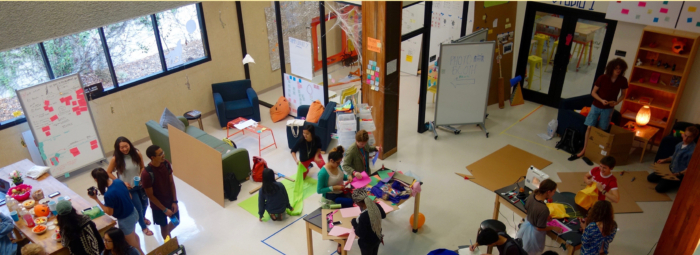
With a new director and a larger space, the Rick and Susan Sontag Center for Collaborative Creativity—better known as the Hive—is strengthened in its mission to inspire students to create, collaborate, and innovate.
The Hive, established in 2015 by Rick Sontag (HM ’64) and Susan Sontag (PO ’64), provides 5C students with a space to work collaboratively, outside of the traditional classroom, into a realm of experiential learning. The Hive began as a pilot program in a space about one-third the size of what it now occupies under the leadership of Harvey Mudd Professor Patrick Little and Pomona Professor Dwight Whitaker. The Hive’s inaugural director, Fred Leichter, joined the staff in July 2016, bringing with him vast experience in business leadership and creative collaboration.
Today, the center includes a number of spaces, with industrious names like The Scrap-Yard, The Vault, and The Toolbox. Each space hosts a variety of hands-on learning experiences, including informal walk-in sessions, workshops, pop-up classes, and for-credit coursework.
“The Claremont consortium is the perfect place to put an interdisciplinary creativity program together,” Leichter says. “These five schools have such distinct personalities. It’s the perfect place to bring those personalities together.”
The Hive fosters this collaboration at all levels. Students, faculty, and staff from across the 5Cs organize workshops on topics as varied as intuitive painting, design thinking, using a loop pedal, and a social experiment, “36 Questions to Make Friends with Anybody.”
According to Katy Lewis ’19, the Hive “does a great job of bringing different kinds of people together to interact in a space that they normally would not interact in. I am always seeing students collaborating on projects, giving each other feedback, and generating ideas.”
Leichter wants to make the Hive a space where students can try new things and learn to be okay when things don’t work out quite right. “Failure doesn’t matter as long as you learn something about what you do,” he says.
Lewis echoes that sentiment: “The Hive is a space where you can learn to fail again, something that is too risky or scary to think about in your classes, which is what makes this space so special and so necessary.”
The Hive also sponsors for-credit classes focused on hands-on learning. Native American Art Collections, co-taught by Pitzer College Professor of Art Bill Anthes and Associate Professor of Art Tim Berg, combines Native American studies, geology, and ceramics. Students extract their own clay deposits from the Padua Hills and create ceramics inspired by Native American art.
During these classes and workshops, Leichter observes students using their skillsets from a variety of disciplines. “There’s a really great benefit when people are working together who are not all engineers or all literature students,” he says. “I hear at least four or five ‘Wows’ a day.”
For more information on the Hive, click here.

